US Rifle Model of 1916
Remington and Westinghouse Mosin Nagant
Rifles
A little known U.S. rifle designated the "U.S. Magazine Rifle calibre 7.62mm Model of 1916"
and a little a little history about them.
I would like to publicly thank Greg Topp for his
contribution to this website
The Russian Contract
Remington and Westinghouse Mosin Nagants were originally part of a contract
with Imperial Russia for up to 1,500,000 rifles from Remington and 1,800,000 rifles from New
England Westinghouse. The contract with Remington was dated November 3, 1916.
Remington received a down payment of $7,500,000 from Russia with manufacture of
rifles starting shortly after. In total there were only
769,520 New England Westinghouse rifles built and 750,000 Remington rifles
built. Of the 750,000 Mosin-Nagant rifles manufactured by Remington, only
469,951 had been delivered to Russia by February 1917. In March of 1917,
Nicholas II was forced to abdicate and the Provisional Kerensky Government took
power. Remington and Westinghouse continued to build rifles during this time.
Remington alone produced as many as 4000 rifles per day during November of 1917.
The Kerensky government continued to accept deliveries from Remington and
Westinghouse.
U.S. Army Training and National Guard Rifles
When Bolsheviks took power the U.S. contracts were cancelled. Remington
and New England Westinghouse faced a terrible economic loss from both Russia
defaulting on the balance of the weapons and because of the United States canceling
the contracts due to not wanting to deliver weapons to the
Bolsheviks. To save Rem-UMC and New England Westinghouse from bankruptcy the
U.S. government purchase the most of the remaining, completed rifles at
approximately $32 each. The majority of rifles purchased by the US were New England Westinghouse
rifles. Most were used for military training purposes was given a temporary U.S.
designation The U.S. Magazine Rifle calibre 7.62mm Model of 1916.
The US made use of the American made M91s to train new Army recruits. US surcharged rifles were kept in the
United States for SATC and other troop training; both the Colorado and the Alaska National Guard, to name a few, had to turn in their US rifles and were instead issued
Mosins. Rifles were proofed and surcharged at a couple of US arsenals, many of them at Benicia Arsenal.
Although most Mosin Nagant rifles that remained in the country were not surcharged but were given to the NRA after the war
ended. Most were brand new when sold off by the NRA at $3.90 + $1.58 postage. The NRA was sold out of
U.S. Mosins by 1929.
American Expeditionary Force
Many U.S. made Mosin Nagant rifles were actually issued to and used to arm
the A.E.F. sailors, including USMC and an Army contingents which were dispatched
to Murmansk, Archangel and Vladivostok during the Red/White Russian Civil War.
U.S. made Mosin Nagant rifles were also issued to British and French troops as
part of the same expedition known and "Polar Bear". The rifles issued
were actually "English Contract" arms already on hand in Britain waiting
for shipment to Russia probably since 1917. The Allies had immediately embargoed
Bolshevic arms shipments. These rifles were confiscated by the U.S. Ordnance
Department on the docks, and were not part of the rifles purchased by the United
States Government (would not have been US surcharged). The majority of which were
of Remington manfacture. These rifles were issued because the Allies
(mistakenly) assumed that there would be ample stocks of 7.62x54R ammunition on hand in Archangel and
Murmansk. Most of the US force committed to
Archangel was comprised of the 339th Infantry Regiment. The 339th were ordered to turn in their
U.S. Model of 1917 Enfield rifles for MN 91s after arriving in England. Most US
troops in Vladivostok though were armed with Springfield rifles, not Mosins.
Mosin Nagants were shipped to Vladivostok to arm the Czech Legion directly
from the manufacturers in Connecticut via the west coast . Some 30,000 1891s were shipped to the Czech Legion from the USA. The Japanese captured a trainload of US rifles on the railway in Siberia, but a quick thinking US Army officer used his troops to surrounded the Japanese and forced them to give back the rifles!
The mission of the AEF in Russia was to prevent the German government from obtaining allied
military goods from Russia and to remove the Bolsheviks from control of the government of Russia. There were 24,000 allied troops in Russia by
1919, 5000 of which were American. It was not a very successful operation, was not at all
popular with the Russians. The Russians have never forgotten while very few Americans are aware that we once fought the Russians on their own
soil with rifles originally made for them. .
The Olympia
The
first American blood shed in the expedition was one of a group of over enthusiastic
Sailors from the USS Olympia who commandeered a train to
pursue a trainload of fleeing red troops. Surprisingly, the Olympia is still
around and currently on display in Philadelphia. One of the last of the pre-dreadnaught warships afloat.
Below are photos and portions of photos from the Signal Corps collection at
the US Army Military History Institute in Carlisle, Pa. They show the US Navy
personnel using US Model 1916 7.62x54 rifles.
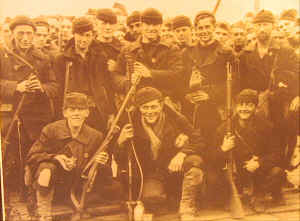
Sailors from the USS Olympia, who formed a part of a landing
force, returning from the line along the railroad to Vologda, where
they had been fighting Bolsheviks. The party got back to its starting
point only after picking its way through swamps and forests. They were
compelled to abandoned everything but their rifles. They are
surrounded by men of the Three hundred and thirty-ninth Infantry, who
just landed in Russia. Bakharitza, Russia. September 6, 1918
|
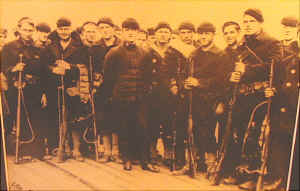
Ensign D.M. Hicks, USS Olympia, and some of the men in his
command, returning from four weeks' fighting at the front. Bakharitza,
Russia. Sept. 6, 1918. The Olympia
Admiral Dewey's flagship in the Spanish American War!
|
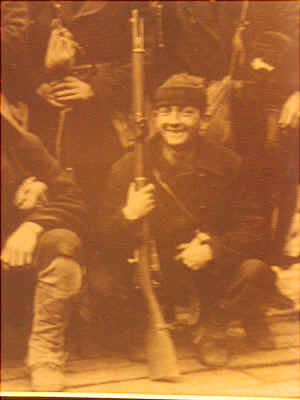 |
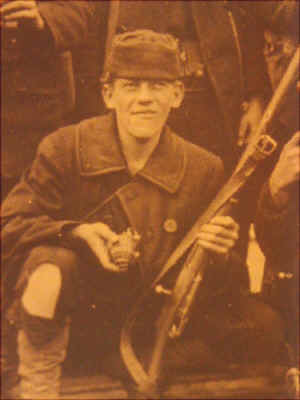 |
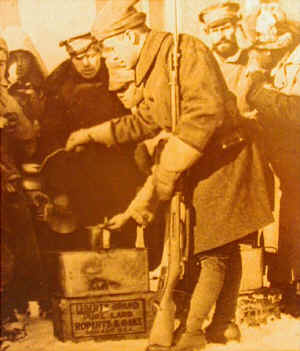
A chow line of Bolsheviki Prisoners of war in Archangel is served by an American Doughboy guard with a ration of rice. The prisoners eat
the rice with large wooden spoons which they carry in their boots.
Oct. 21, 1918.
|
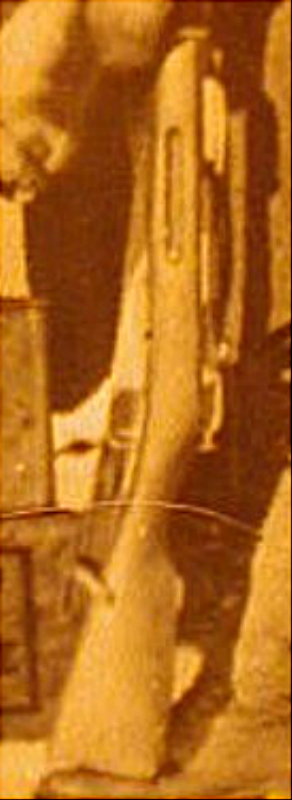 |
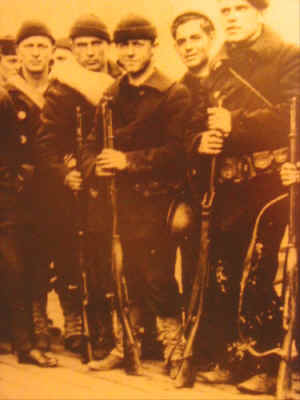
|
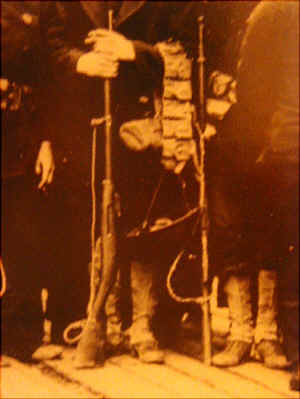 |
| Link to a Archangel Memorial Day Parade
from the Polar
Bear Memorial Association Website
Marching
with Mosin Nagant rifles
|
Link to picture of rifles ready for
shipment to Russia from the Remington
Society Website
Mosin
Rifles on the docks
|
|
Picture from Russian Railway Service Corp in Japan
and Siberia Website
Czech
Soldier with Mosin Nagant Rifle
|
|
Could your US Made Mosin be Traced to the
AEF?
Unfortunately, probably not. Most of the rifles that the U.S. troops took to Archanglesk in 1919 were abandoned
upon departure in
1920. The only real reason the guns were issued to them was for logistics. The troops, who were accustomed to
M1903's and M1917s, hated the M1891's. Allies destroyed massive amounts of equipment when they abandoned the mission believing (correctly) that the White Russian army they were leaving behind would evaporate quickly and most of the equipment would fall into the hands of the
Bolsheviks. So of the few rifles used by the AEF that may be remaining. The
rifles were originally part of the original shipment intended for Russia and so
not US surcharged. They would be identical to previous rifles shipped to Russia.
Still there are many Russian used US made Mosin rifles in collections. Some
Rifles used by the Russians and Soviets during WWI, during The Winter War with
Finland, and even during WWII. Many rifles also ended up in Finland because of the very large number of Russian troops stationed there prior to the Finnish war in
1919. The Finns captured huge numbers of Mosins from the Bolsheviki troops. Also, Germany may have supplied captured Mosins to Finnish patriots prior to the end of WW1, and certainly sold thousands of them to Finland during WW2.
Many of these rifles were refurbish by the Finns for their use. Finnish Mosin
Nagants will be marked with the SA marking. Some even with Regimental or Civil
Guard markings. If any M1891 Remington or New England Westinghouse Mosin with both Finn and US surcharges exist, the rifles would probably have come from Spain after the Spanish Civil War. Spain sold lots of their captured weapons to Finland, and that included some of the US surcharged MN bought on the open market by countries friendly to Spain
such as Mexico. Of the rifles given to the Czech Legion, many were sold/given by the Soviets to the Chinese Reds in the
1920s. It would be a difficult assumption to trace any Mosin Nagant rifle to the
American Expeditionary Force in Russia.
Not the only Foreign Rifle Used by American
Troops in WWI
French Berthier Lebel 1907-15 rifles were issued to at least some U.S.
troops. Some possibly even Remington made. Not widely reported is the145th
Division who we loaned to the French 4th Army. Black troops in US uniforms with
White US officers. All due to U.S. racial policies. The French had no problem
with blacks and welcomed them. The US loaned troops were issued French
weapons, including the Lebel. The French Lebel bayonet could not be carried on
the US web belt so French gear of leather rather than web was worn. The 369th Infantry Regiment, formerly the 15th New York National Guard, known
later as the "Harlem Hellcats" did use the rifles in combat.
After training under French command, they went into action at Bois d'
Hauya, holding for two months an entire sector against German fire. The 369th
also fought at Minacaurt, Maison en Champagne, Meuse-Argone, Butte de
Nesil, the Dormois, Sechault, Argonne Forest, Repont, Kuponase, Voges Mountains,
the Aisne, the Turbe, Fountain and Bellevue Ridge and Somme offensives. The
German's nicknamed them "Hellfighters."
A Collection of Relevant Links
Remington
Society Website: Pictures and facts about the Remington contract
Die Hards
in Siberia by John Ward: Free online E book.
Detroit
News article: Detroit's Polar Bear's and their confusing war
Russian
Railway Service Corp in Siberia
Michigan
History Magazine: Michigans Polor Bear Soldiers in WWI
Correspondence
of Cpl. Clement A. Grobbel: "It's like hunting rabbits only on a bigger
scale"
WWI Trenches on the Web:
American Polar Bears AEF
Polar
Bear Memorial Association Website. Lots of pictures and further links
Australian Sergeant with
the British Mission: MEMOIRS OF SERGEANT KELLY
Dr. Faltin Website: Photos
documenting the Czech Legion during the Russian Revolution
Aid Memoir of 17
July 1918 directing the Archangel Expedition
Click
here to go back to the main page.








